Engineering for health projects
We have a number of projects and collaborations in progress
Statistical signal processing for assessing functional recovery in spinal cord injury
Principal investigator: Dr David Halliday
Collaborators: Spinal Cord Injury Center, Balgrist University Hospital, Zurich; University of Strathclyde
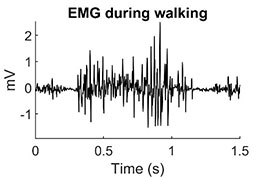
The activation of muscles when moving are controlled by motor neurons from the spinal cord. Electrical activity from motor neurons can be detected noninvasively using electromyography (EMG). These signals provide a window back into the complex neural circuits of the spinal cord and brain that control movement. This project is concerned with application of advanced statistical signal processing to EMG signals to investigate functional recovery following Spinal Cord Injury.
For further information, visit the Computational Neuroscience Lab website or email david.halliday
Functional brain networks in health and disease
Principal investigator: Dr David Halliday
Collaborators: University College London; National Hospital for Neurology and Neurosurgery, London; University of Oxford.
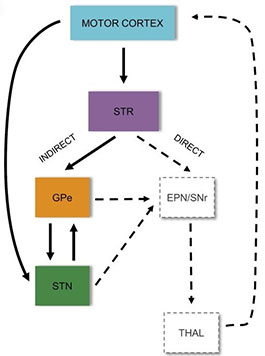
The ability to characterise functional interactions in the nervous system is fundamental to understanding the operation of the healthy and diseased nervous system. This collaborative project is concerned with the development, implementation, validation and application of statistical signal processing tools for quantifying functional interactions between electrical recordings from the human nervous system. The work focuses on understanding control of voluntary movement and the pathologies present in movement disorders.
For further information, visit the Computational Neuroscience Lab website or email david.halliday
Analysis of sex difference in brain activation using multi electrode array data
Principal investigator: Dr David Halliday
Collaborators: University of Nottingham.
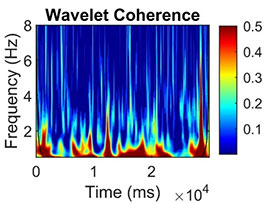
An increased prevalence of post-traumatic stress disorder (PTSD) is observed in women compared to men. This may reflect sex differences in brain activity in response to environmental cues. This project considers how electrophysiological correlates in response to different environmental cues can be analysed using frequency domain methods to characterise and quantify the observed behavioural differences. The techniques are part of a large suite of signal processing tools for analysis of multi-electrode array (MEA) recordings, and have broad applicability to study the mammalian nervous system.
For further information, visit the Computational Neuroscience Lab website or email david.halliday
New technologies to quantify protein secretion at the single cell level
Principal investigator: Dr Steven Johnson
Collaborators: Thomas Krauss (School of Physics, Electronics and Technology), Ian Hitchcock, Paul Kaye, Peter O’Toole, Jennifer Southgate, David Kent (Biology)
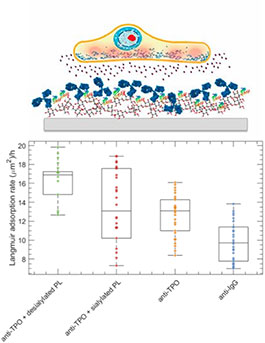
The function of cells within our bodies is coordinated by molecules that are passed between them. To properly understand these signalling events, we need tools that allow us to understand how different types of cells secrete these molecules, and how such messages propagate. Current tools either measure secretion from a large number of cells at a single time point, may interfere with physiological function by using labels, or they have to destroy the cells in order to analyse them.
We have developed a fundamentally different imaging technique, which we term “Phenospot”. The technology is based on optical resonances in photonic nanostructures that allow us to monitor the response of live cells in great detail. We have already applied the technology to understanding the effects of human platelets on mediating the release of the protein TPO and are continuing to develop Phenospot to address a range of biological questions across vaccinology, haematology and cancer.
Label-free, photonic technologies for the detection of protein biomarkers
Principal investigator: Dr Steven Johnson
Collaborators: Thomas Krauss (School of Physics, Electronics and Technology), Gavin Thomas (Biology), Anne Duhme-Klair (Chemistry)
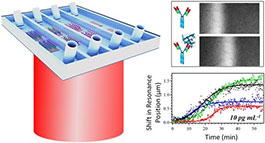
The rising cost of global healthcare provision and new approaches to managing disease are driving the development of low-cost and easy to use diagnostic devices. We have demonstrated a new diagnostic technology that is based on optical resonances in photonic nanostructures.
Using this technology, called a guided mode resonance (GMR), we have shown the detection of multiple protein biomarkers of disease in parallel and in undiluted urine samples.
We are currently working with clinicians at the York Teaching Hospital NHS Foundation Trust to translate this technology for a range of applications, including early diagnosis of infectious diseases and management of rheumatoid arthritis.
Sensors for clean water: a participatory approach for technology innovation
Principal Investigator: Dr Steven Johnson
Collaborators: Jonathan Ensor (SEI), James Moir (Biology)
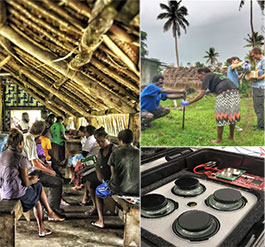
It is estimated that more than 1.5 million children under five years old die every year from diarrhoeal diseases due to drinking unsafe water. This project aims to work with poor communities in Vanuatu most affected by this problem, in order to develop water monitoring technologies that will provide assurance about the safety of their drinking water.
Traditional approaches for technology development, where technologies are developed for people, rather than with and by communities, tend to have limited impact. We have developed a different approach, that we call Integrated Participatory Technology Development (iPTD).
iPTD embeds communities at every phase of technology innovation, from defining the initial technology specification, through to design, testing, and optimization. By working with communities from the outset, we will ensure sensing technology that is designed precisely to meet the needs, skills and environment in which the community live.
Body composition measurement
Principal investigator: Dr Martin Robinson
Collaborators: Leeds General Infirmary, Leeds Beckett University, University of California San Francisco
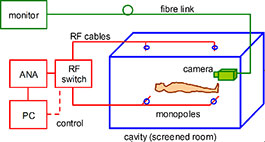
Measurement of total body water provides useful information in conditions such as kidney failure, heart problems and obesity, and is also valuable in sports science. Radio-frequency measurement of hydration by resonant cavity perturbation (RCP) is fast, comfortable for claustrophobic patients, avoids the use of ionising radiation (X-rays) and more accurate than current bio-impedance devices
For further information, visit the visit the Physical Layer Research Group website or email martin.robinson
Microwave absorption in a reverberant environment
Principal investigator: Dr Martin Robinson
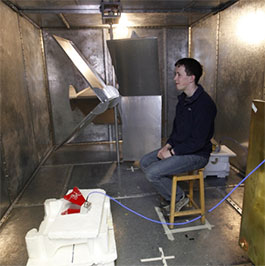
Absorption of microwave power by the body needs to be monitored to ensure the safety of people exposed to radiation, and the absorption cross section (ACS) of the body is also useful in determining the body’s effect on microwave propagation.
Measurements in a mode-stirred chamber with rotating paddle enable ACS of a human subject to be determined safely over a broad range of frequencies within a few minutes, providing values that are representative of exposure in a reverberant environment such as a train or aircraft cabin.
For further information, visit the visit the Physical Layer Research Group website or email martin.robinson
Magnetic biosensor nanowires
Principal investigator: Dr Iain Will
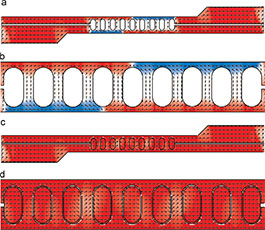
We have shown that substrate-bound nanowires made of permalloy, with receptor sites for magnetic nanoelements, are able to induce an anisotropic magneto-resistive effect in nanowire circuits.
The permalloy nanoelements are designed to be bound by antibody-mediated interactions with biological ligands at the receptor sites, in order to act as an inexpensive diagnostic biosensor.
For further information, visit the visit the Spintronics and Nanodevices Lab website or email iain.will
The development of new targeted alpha therapy device for cancer treatment
Principal investigator: Dr Christian Diget (School of Physics, Electronics and Technology)
Co-investigator: Dr Samadhan B Patil
The project aims to combine expertise from York in nuclear detector developments, microfluidics, and digital electronics with expertise from the Institute for Advanced Medical Isotopes (IAMI) at TRIUMF to advance the production of novel alpha emitters and facilitate the development of new TAT pharmaceuticals.
For further information, email samadhan.patil
Movement and balance in long COVID-19
Principal investigator: Dr Ximena Levy, MD (Florida Atlantic University Medical School)
Co-investigators: Dr Scott Alter (Florida Atlantic University Medical School), Dr Waseem Asghar (Engineering and Computer Science Department, Florida Atlantic University), Dr Shirley Gordon (Florida Atlantic University Medical School), Dr Elan Barenholtz (Center for Complex Systems & Brain Sciences, Florida Atlantic University), Dr Adar Pelah (School of Physics, Electronics and Technology, University of York).
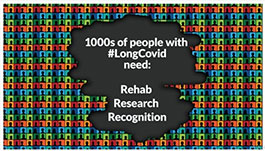
The project assesses movement, balance and gait in up to 1,200 patients, and additional controls, who have recovered from the COVID-19 viral infection.
Patients can experience a condition referred to as long COVID that can present variably with a range of symptoms, including neurological, cognitive and musculoskeletal. Patient movement is captured, analysed and classified using technology developed in the Laboratory for Intelligent Virtual Environments, in collaboration with colleagues and University of York spinout company, Asuuta Ltd.
Results may lead to an increased understanding and treatment approaches for the growing problem of long COVID (longcovid.org). The study runs alongside the CRU – COVID 19 Registry and Repository programme at Florida Atlantic University Medical School.
Machine learning diagnostics in potential stem cell treatment for osteoarthritis
Principal investigator: Dr Adar Pelah (School of Physics, Electronics and Technology)
Co-investigators: Prof Paul Genever (Department of Biology, University of York), Mr Greg Quinn (Consultant Orthopaedic Surgeon, York Hospital), Mr Mark Andrews (Consultant Orthopaedic Surgeon, York Hospital), Dr Nicholas Shenker (Consultant Rheumatologist, Cambridge University Hospitals), Dr Thomas Stone (Cambridge Clinical Movement Lab, Cambridge University Hospitals)
Osteoarthritis (OA) is the leading cause of disability worldwide, and a currently incurable condition that causes pain and restricted gait and movement. Developments in stem cell treatments are showing promise for OA but their efficacy depends on early or pre-symptomatic identification of symptoms.
This MRC-CiC funded project captures the gait and movement in common and genetically pre-disposed manifestations of OA for the development of machine learning algorithms for diagnosis and predictive classification of the condition. The results offer an assessment of OA and potentially a means of sign-posting patients for stem-cell and other treatments.
Virtual reality based biofeedback for reduction of complex pain
Principal investigator: Dr Nicholas Shenker (Consultant Rheumatologist, Cambridge University Hospitals)
Co-investigators: Dr Adar Pelah (School of Physics, Electronics and Technology, University of York), Dr Thomas Stone (Cambridge Clinical Movement Lab, Cambridge University Hospitals), Elsje de Villiers (Research Physiotherapist, Cambridge University Hospitals)
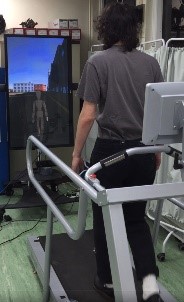
Complex pain can affect the movement and gait of patients in sometimes debilitating and life-altering ways. This Royal Academy of Engineering funded study evaluates the efficacy of virtual reality biofeedback treatment in primarily lower body movement as it affects walking, using motion capture and VR technology developed in the Laboratory for Intelligent Virtual Reality (LIVE).
Preliminary results in the treatment group compared to controls show a statistically significant improvement in measured walking parameters such as distance walked as well as a marked reduction in patient’s subjective pain scores.